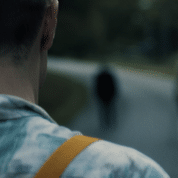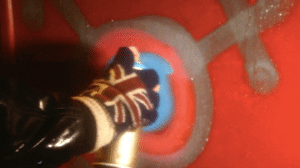Dir: Carmen Emmi | 95′ USA/UK co production
Reviewed by Peter Herbert
Plainclothes is a complex, sensitive indie film bristling with multi-layered energy exploring life’s eternal challenge of sexual repression.
The main focus of the film is an American shopping mall where a public toilet was referred to as a “tearoom” serving rather more than a hot cup of tea. This is slang reference for a ‘toilet’ used by men looking for clandestine sex that could also be dangerous.
The film is set in 1990’s America when homosexuality was still far from accepted or legal, the use of tearooms created a range of problems for men. Arrested and sentenced in court with public and private lives damaged and destroyed, many were also targeted by attractive police officers acting as decoys wearing off duty plainclothes.
Plainclothes has perceptively captured this social and sexual landscape by debut film director Carmen Emmi. The inspiration of the film is an original tearoom in Ohio which was filmed by law enforcement officers in 1963 using a two-way mirror to conceal cameras. This footage, used in courts as evidence and also for training police officers resulted in the arrest of 60 men. The footage has also been used by William E Jones in 2007 as a gallery installation which erased the derogatory voice-over commentary, turning the footage into a silent study of the ritualistic sexual behaviour between men who entered the tearoom. The footage has also been edited by Emmi into an accurate recreation of the Ohio tearoom.
Although the film is aware of the sociological value of this footage it is more interested in creating a narrative out of material that also mixes together a multi layered visual texture of analogue, 16 mm, VHS video and other 1990s film formats. This enhances the film’s central focus on Lucas, a young police officer played by Tom Blyth. He is a complex man with dysfunctional family elements involving mother and father issues, troublesome relatives, friendships and a still loving former girlfriend whom he never loved. These scenes are filled with the naturalistic visual detail of the tearoom sequences.
The film creates a further twist when Lucas meets an older man played by Russell Tovey whom he traps but soon becomes drawn into a relationship that acts as a catalyst for the unlocking of his own sexual cover-ups.
Performances of the central characters and ensemble cast are remarkable. Tom Blyth captures sensitive nuances of a man trapping others while delving into his own repressed desires. Russell Tovey continues to explore his range as an actor with another fearless portrait of gay life. Here, he is a quiet, decent and good man harbouring a deeply secret “other life”. This is the reversal of his dark troubled beefed up and angry police cop in Ryan Murphy’s American Horror Story: NYC (2022) where he was the rough hunter as opposed to sensitive victim here
The film could be seen as a comment on William Friedkin’s unjustly maligned Cruising (1980) with similar themes in which Al Pacino played a deeply sexually troubled cop. Visually, Plainclothes is remarkable for knowing references to key scenes in the cinema of cruising. The setting of an ornate rococo style cinema is comparable to the cruising scenes in in Rene Clement’s This Angry Age (1956), Tsai Ming-Liang’s Goodbye Dragon Inn 2003) and Ferzan Ozpetek’s Nuovo Olimpo (2023).
Plainclothes has a sense of cinema architecture as a place of dreamy ornate beauty in which cruising in darkness and silence reflects the glow and allure of a fantasy on the screen. In doing so, the film should be recognised in its own right as an important addition to the canon of gay cinema @Peter Herbert
IN UK CINEMAS FROM 3 OCTOBER 2025



